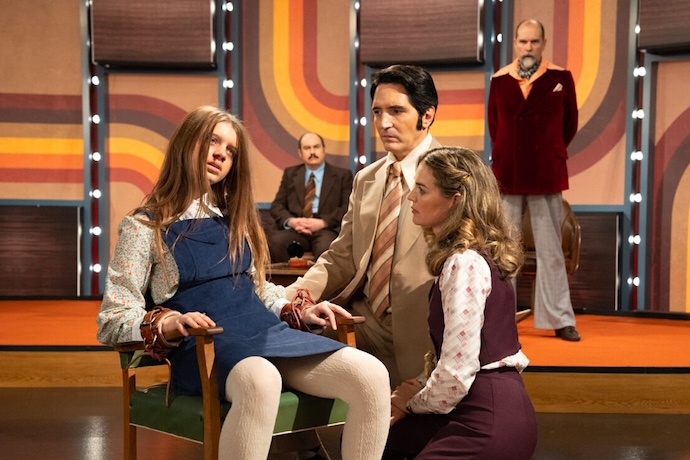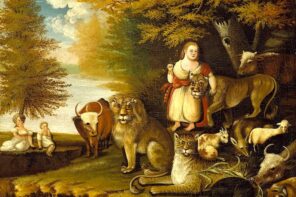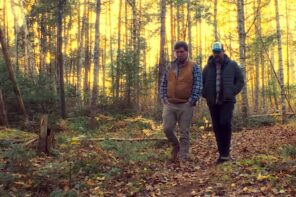Late Night with the Devil premiered in select cities this past weekend, allegedly raking in $666,666 on Sunday. This indie gem by Cameron and Colin Caernes is a “found footage” horror film, purporting to be a lost episode of a late-night talk show called Night Owls that aired on Halloween 1977. Faced with faltering ratings and imminent cancellation, host Jack Delroy (David Dastmalchian) takes a chance by bringing on a series of spooky guests, including “Lilly,” a girl who was rescued from a Satanic cult and is allegedly possessed. The story is a bizarre mashup of The Exorcist (1973) and Network (1976)—with a touch of the Faust legend thrown in—that perfectly captures the mood and style that surrounded media depictions of the occult in the 1970s.
Despite its supernatural premise, Late Night with the Devil is a work of realism. Most of the characters and events in the film are references to actual figures from 1970s occulture. It also reflects on the way that talk shows became a vector through which rumors of Satanic cults spread, fueling the Satanic Panic of the 1980s. As described in my book The Exorcist Effect, filming a live exorcism was a goal of network news media for two decades.
Beginning in the 1960s, the secularization narrative—the belief that science will soon render religion obsolete—coincided with surging interest in the occult. In 1966, Time ran its famous “Is God Dead?” cover, which can be spotted in Rosemary’s Baby (1968) and the combination of red font on a black background continued to be used in The Exorcist (1973) and The Omen (1976). Sociologist Peter Berger, in his 1974 essay on The Exorcist, suggested that fascination with the occult was a reaction to secularism: “Let me, then, state a simple hypothesis: The current occult wave (including its devil component) is to be understood as resulting from the repression of transcendence in modern consciousness.” The networks also noticed public fascination with the demonic and otherworldly and they scrambled to cash in.
In April 1971, NBC Chicago aired an exorcism on live television. Camera crews arrived to film William Derl-Davis, a reverend from the Independent Spiritualist Church in Chicago, and medium Joseph DeLouise exorcise the home of two newlyweds who claimed to be experiencing strange disturbances after moving into their new apartment. The crew were given crosses to wear for protection. DeLouise entered a trance and assumed the persona of an old woman whose spirit could not rest. Derl-Davis administered communion to the spirit and the exorcism was declared a success.
Months later, William Peter Blatty published his novel The Exorcist. It was initially a flop until Blatty received a last-minute invitation to appear on ABC’s The Dick Cavett Show. In what may have been demonic intervention, Cavett’s other guests canceled and Blatty was allowed to spend 45 minutes hawking his book. Suddenly The Exorcist was a best-seller.
After Exorcist mania swept the country, the networks again began looking for a live-exorcism—but they wanted a Catholic priest rather than a Spiritualist. They began courting Father Karl Patzelt, an Austrian-born Jesuit who, in 1973, performed a series of exorcisms with his bishop’s permission to cleanse a home in Daly City, California. After CBS radio learned of the story, reported in The National Jesuit News, a producer phoned Patzelt to ask if they could film his next exorcism. Patzelt refused, but he did appear on NBC’s The Tomorrow Show as part of a panel of priests discussing The Exorcist, which Patzelt dismissed The Exorcist as “a junky movie.” But he was able to parlay his appearance on network television into a speaking tour, traveling to Fordham and other universities around the country to discuss the reality of the demonic.
On Late Night with The Devil, Jack Delroy’s final guests were a parapsychologist named June Ross-Mitchell and Lilly, a young girl who was rescued from a Satanic cult led by Szandor D’abo—an obvious reference to Church of Satan Founder Anton Szandor LaVey. Ross-Mitchell went on Night Owls to promote her new book on her experience studying and healing Lilly called Conversations with the Devil. Lilly’s story is references not only The Exorcist, but Michelle Remembers, a 1980 book written by psychiatrist Lawrence Pazder and his patient-turned-wife Michelle Proby. Although it was thoroughly debunked, descriptions of Michelle’s repressed memories of being tortured in Satanic rituals as a child jump-started a wave of claims about “Satanic Ritual Abuse.” Again, talk shows became a key vector through which Pazder and others disseminated these stories.
As tastes shifted from exorcism to Satanists, the networks were happy to oblige. In 1985 20/20 aired its episode “The Devil Worshippers.” Having no actual Satanists to show the audience, it aired footage from Rosemary’s Baby while an announcer declared that actual Satanic cults were much like the ones in the film. In 1987, the FCC eliminated the fairness doctrine, freeing the networks to flood the air with salacious “infotainment.” Satanic cults were covered on Sally Jesse Raphael, Oprah, and Geraldo Rivera’s 1988 special, “Exploring Satan’s Underground.”
In 1990, John O’Connor, cardinal of New York, gave a sermon warning about the dangers of demons, Satanic crime, and rock music, even reading from The Exorcist in St. Patrick’s Cathedral. In the news cycle that followed, ABC’s 20/20 set to work trying to film an exorcism. This time they got what the networks had long sought. James LeBar, exorcist for the Diocese of New York, found a family in Palm Beach, Florida willing to let camera crews film an exorcism of their 16-year-old daughter, Gina. On April 5, 1991, audiences saw a priest cast various spirits out of Gina, set to Carmina Burana’s “O Fortuna.” Producer Rob Wallace remarked on this event, “I came away believing that possession was possible, and that it can happen, and, in fact, we may have witnessed possession and the exorcism of demons.”
The 20/20 episode was followed by Nightline, where Ted Koppel interviewed a panel of priests. Father Richard McBrien, a Notre Dame theologian, said the segment was irresponsible and that regardless of any agreement between ABC and the family, this was a violation of Gina’s privacy. He followed this up with a column for The Catholic Courier where he stated that O’Connor’s 1990 sermon, as well as the 20/20 segment were part of “hidden agenda”:
The real objective of that project, I submit, was to help bring back that old-time religion when everyone, women especially, knew their place, when Catholics obeyed without question every directive from on high, and when there was never any question that the Catholic Church was the one, true church with all the answers to all the important questions we have about life, both here and hereafter.
But many lay Catholics saw McBrien as an apologist for the Devil. One respondent wrote, “My faith tells me that the devil is real and the ‘20/20’ program was allowed by God to show that reality. The show proved that Jesus is more powerful than Satan.” After all, what does a Notre Dame theologian know about the Devil compared to 20/20?
Like many supernatural horror films, the ending of Late Night with the Devil is ambiguous. Was Jack Delroy simply so desperate for ratings that he turned to the demonic? Or were darker forces conspiring to make Night Owls successful just so a young demoniac created by Szandor D’Alba would have the opportunity to reveal her powers on a national stage? Was the network meddling with the devil or was it the other way around? Either way, the result is gruesome mayhem, an apt metaphor for the demonic paranoia that real life networks have unleashed in their quest for ratings.





